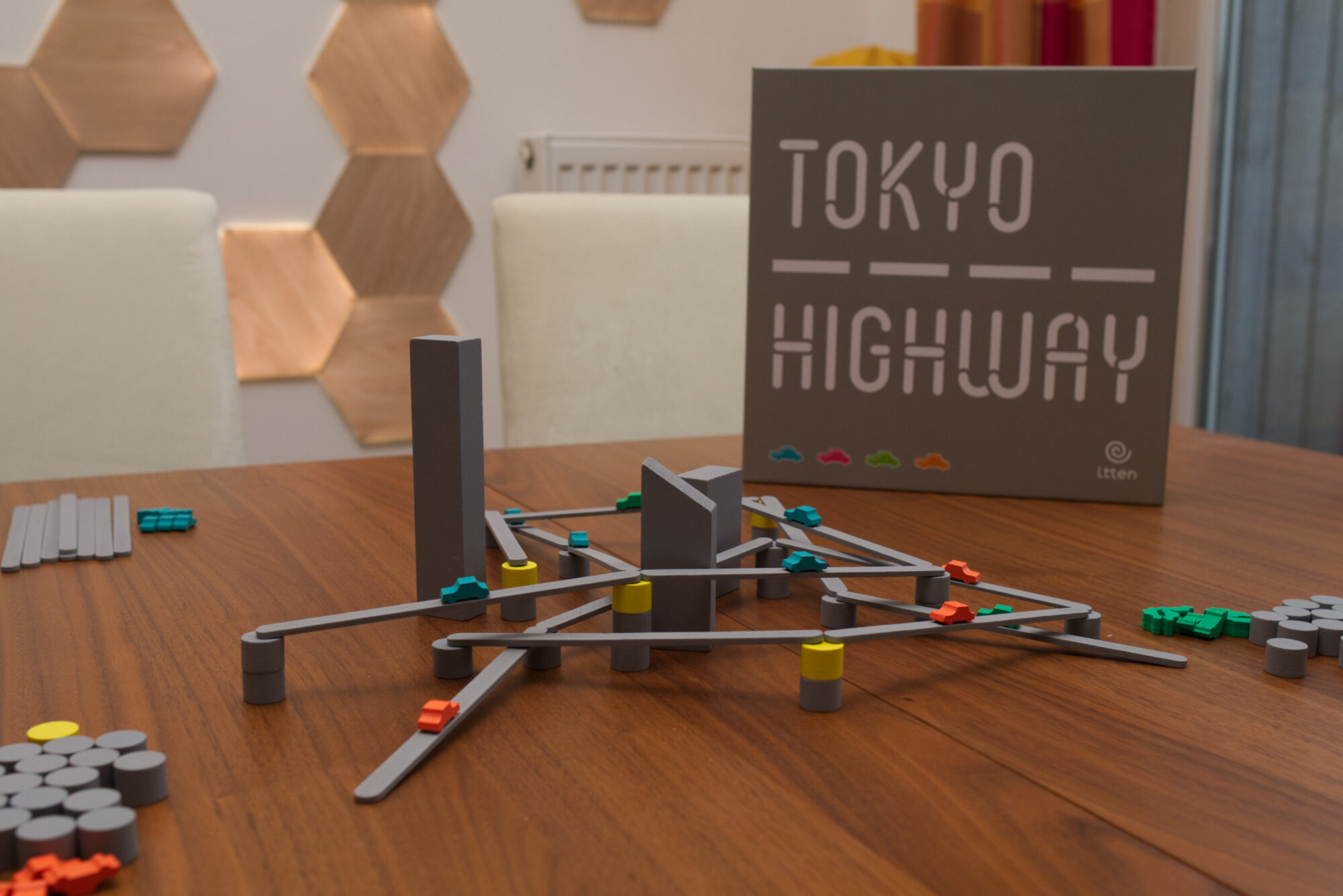Have you ever won a game by making your opponent laugh too hard? I have! We were playing Tokyo Highway and the absurd difficulty of the manoeuvre they were trying to pull off just to score one more tiny car simply got me. I couldn’t help myself and started laughing, they laughed, hands shook, and wooden pieces sprawled all over the table as the glorious chaotic structure we had been building up came down.
I don’t even remember what originally led me to get a copy of Tokyo Highway as it is pretty much the only dexterity game I own. I must have seen images online and thought “what is that?!?” or something like that. Anyway, it’s a cute little game I still enjoy a great deal, so much so that I even imported the hard to get Cars & Buildings expansion for it from Japan. Now with a new edition and second expansion being in crowdfunding, it seemed like a good time to finally write about Tokyo Highway.

Differences in Editions
First of all, I have to clarify: what I own is the 2018 2-4 player edition of Tokyo Highway which comes in a standard Ticket-to-Ride-sized box. There is also a 2016 2p only edition in an adorable small box that is functionally the same but besides the component for the two additional players also lacks the buildings. All components in both of those editions are wooden, except for the included tweezers – the fact that the game already comes with this component included I still find amusing every time I open the box.

The new edition that is currently (as of writing this in February of 2024) on crowd funding is different in two major aspects: the cars are now made out of a less slippery, hard rubber material and the street elements now have small non-slip pads on both ends of the underside. I guess this is a move to make the game more accessible to a wider audience, but I remember how surprised I was when I first learned about this. Typically, dexterity games try to make things harder on you, not easier.
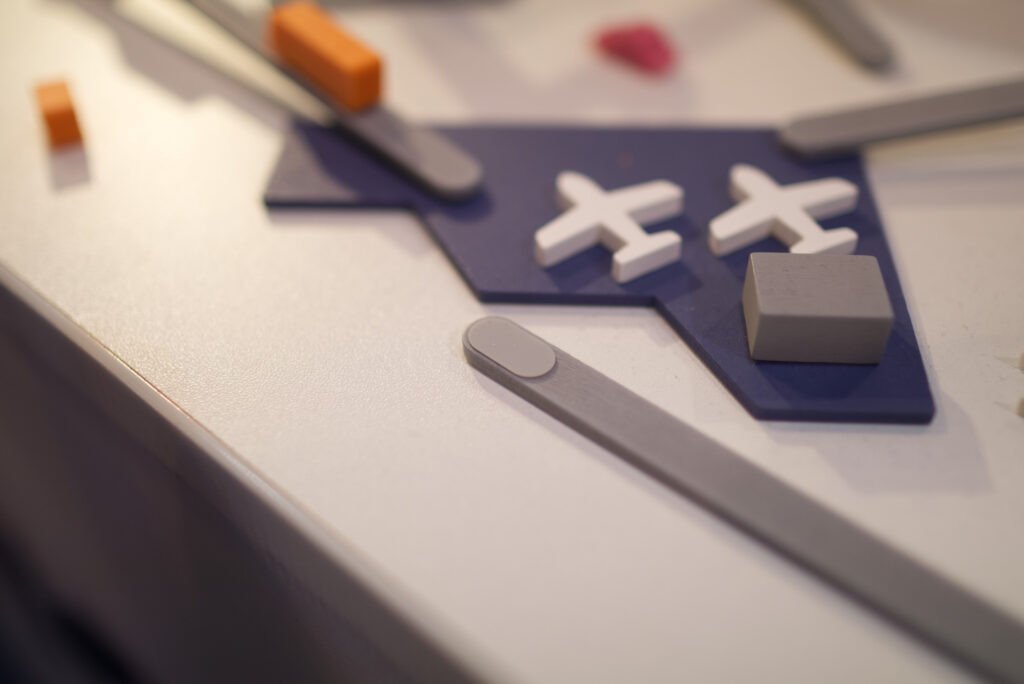
Setup
With that out of the way, let’s dive into setup. It’s rather simple: each player gets a set of tiny cars in their player colour, 3 yellow wooden cylinders that represent junctions, a whole bunch of grey cylinders that represent the pillars on which the highway will be build, and a number of long wooden sticks that represent the road. The specific number of pillar and roads vary with player count but suffice to say they feel like a lot in the beginning and one runs out of them surprisingly quickly.
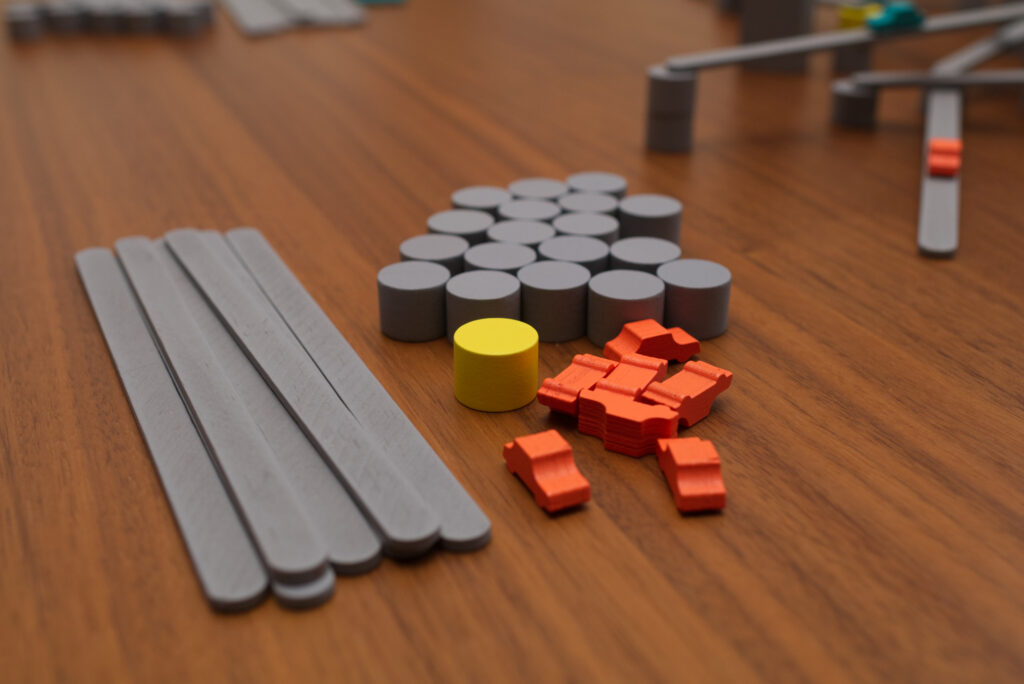
To kick off the game, every player takes one of their pillar tiles and roads, places the road from the table’s surface up that one level, and then marks it as their own by placing one of their cars on it. The pillars are arranged such that they are exactly one road’s distance away from those of the opponents. Then in reverse order, players pick one of the four large blocks that represents the city’s buildings and places it anywhere they want. These simply act as obstacles, no additional rules needed.

The Turn
When it’s a player’s turn, they must add one road segment to their own network of roads. There are a handful of rules for this: the roads of different players never connect and throughout the whole game, they just zig-zag around or cross over/under the other players’ roads. A road cannot be placed such that it crosses over a pillar or touches another road segment. A new road segment has to start off the existing road and be placed on a new pillar that is either exactly one level higher or one level lower than the starting point. Each pillar can only have two road segments on it, except for the yellow junction tiles where there can be three. Placing a new junction also allows for that segment to go up or down more than one step in one go. And a player can only place a road segment so it touches the table’s surface (called an off-ramp) if they have somewhere else to continue building in the next round.

So far, so good, you might say, but what’s the motivation for this? Every time a player’s road crosses under or over an opponent’s road AND it itself is the lowest or highest road crossing, the player can place one of their cars on there. Same when creating an off-ramp. First player to place all their cars wins.
The result of these building rules is that players constantly try to outmanoeuvre each other so THEY are the ones going over the other players’ roads, not the other way round. They want to be close to other players’ roads to be able to seize an opportunity if one should arise, but not so close that they get crossed. The key here is this somewhat tricky on first plays rule of being the highest/lowest road, so let me give you an example. In the image below, the road coming from the right, crossing over the orange road and under the blue one, doesn’t have a car on it. Why is that? It is of the same player as the orange one that starts off the table surface, so that doesn’t count. But it is also not the lowest street crossing the blue street. Hence, the orange player is not allowed to place a car when building that road segment.

Game End
While building more and more risky constructions, the obvious question is of course what happens if a player knocks something down. If it’s part of your own network, just put it back in place as best as you can, no harm down. However, for every piece of an opponent’s network – being it pillar, road, or car –, you’ll have to hand them over one of your pillars from your supply for each element that had hit the table and then put everything back into place. If any player runs out of pillars, they are automatically disqualified and out of the game.
So there are two ways how Tokyo Highway can end: one player manages to place all of their cars – or – all except one player have run out of building material. And that’s pretty much it. Besides the “when are you allowed to place a car” rule, everything else is rather straight forward and quick to learn.
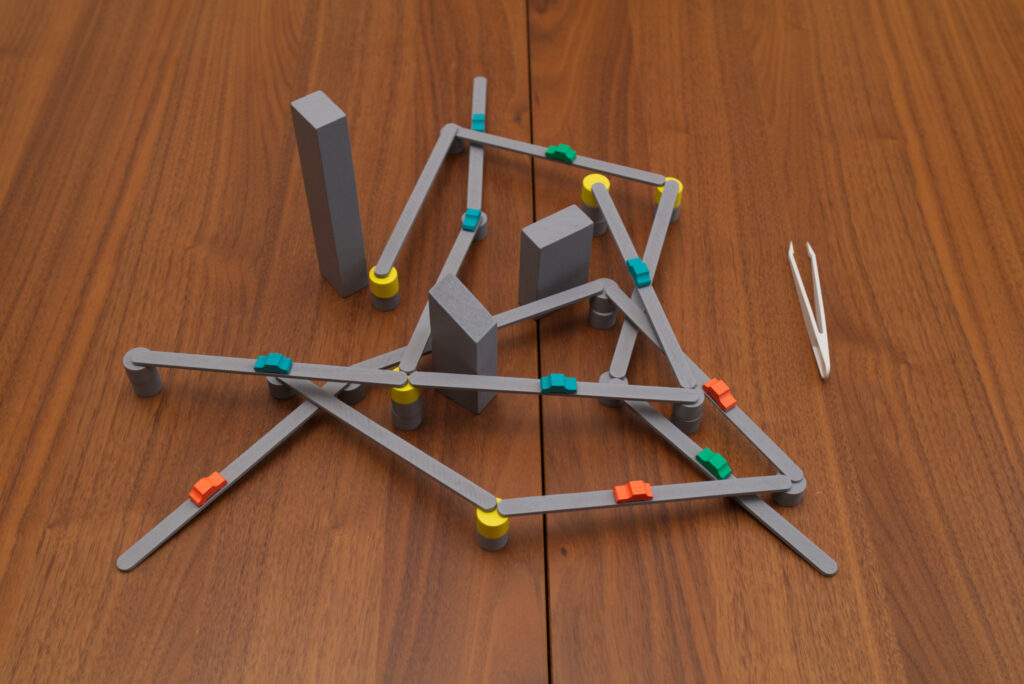
Expansion 1: Cars & Buildings
While the 2-4 player edition of Tokyo Highway saw wider publication outside of Japan, its first expansion “Cars & Buildings” unfortunately never did so. So it’s a bit of a pricy undertaking to import this hand-size small box from Japan but I was just too curious.
The key element is that each player now gets the same set of 10 individually shaped cars, each with a special unique power or limitation: The standard sedan of the base game is just used to mark a player’s starting road, the electric car can only be placed on an uphill road, the delivery express steals two pillar pieces from an opponent, the sports car has you place an additional road immediately, and so on. The jumbo truck allows placing one of the four new buildings that also comes in the box mid game, which always is good for a little bit of mischief. The family wagon is a bit quirky at it tells players to take a picture and share it on social media. We always skip that one…

And that’s it. Otherwise all the normal rules of the base game apply. The expansion is mainly for players that have played Tokyo Highway a lot and are looking for a little bit more. I’m glad I got it and it slightly spices up the difficulty, but more often than not, I don’t even bother getting it off the shelve. In my groups, we play Tokyo Highway once every couple of months or so and for that, the base game alone feels fresh enough every time. So I would recommend it if you’re a couple or family that likes playing Tokyo Highway often and need something more.
Expansion 2: Rainbow City
I actually had the chance to see (but unfortunately not play) this upcoming expansion in person during my visit to Essen SPIEL 2023. One thing Rainbow City brings to Tokyo Highway and that immediately drew me to that part of publisher Itten’s booth is there is now a lot more colour and personality! The stadium, rainbow, and airport definitely make the game look less like an abstract and more like an actual toy town. Maybe even a little bit too much. The fact that the base game had all non-player components (except the few junctions) in a neutral gray made for good readability and helped the player pieces to pop.
Based on the currently published rules on the Kickstarter page, setup changes by players first placing the five “development areas” (wooden oddly shaped thin tiles) and only afterwards placing the four buildings on them. Road pillars can be placed on development areas, but of course it must be so that there is no overhang. Development areas count as table surface, so one can use them for off-ramps to place a car, same as for the rest of the table’s surface. No pillars may be placed on the airport or stadium, but they also can act as off-ramps. However, no column or road may be placed on the rainbow tile (I guess the rainbow spans over a lake), but passing a road underneath the rainbow allows placing a car on the road.
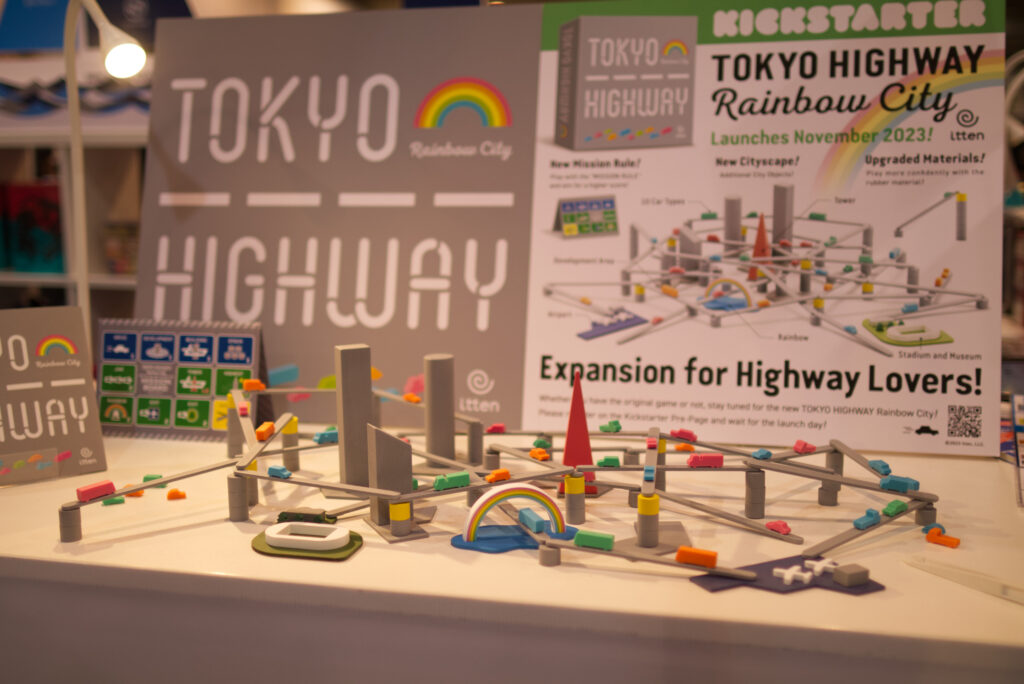
The “mission rules” are an alternate, advanced scoring mode. Each car placed scores one point and achieving certain targets like surrounding the red tower scores additional points. The game still ends as usual, but the player with the highest score wins, not the one that placed all their cars.
Finally, the expansion also contains the exact 10 car types and four buildings that were in the Cars & Building expansion, so that one becomes obsolete now unless you prefer to have the wooden cars over the rubberised ones.
As I mentioned in the beginning, the new edition of Tokyo Highway that is on crowd funding uses rubberised cars and has non-slip pads on the street segments. For owners of the original Tokyo Highway, the expansion comes with self-sticker pads that can be attached to the existing roads that come in the base game. While I can see the benefit of the non-slip roads, I’m not too sure about the cars yet. It was always fun that placing a car was risky as it might simply slide off the road if it lies at a slight angle. On the other hand, placing a car on a legal 2-level up road (due to a junction) was painfully difficult. Since I already have the wooden cars, I can see myself use the new roads but keep using the old cars. Or sell the expansion in time before prices tank. We’ll see …
Conclusion
Tokyo Highway is a quirky, fun, not that serious dexterity game with great table presence. Most people I’ve met only need to see the tiny adorable cars and go “oooh, what’s THAT?”. It’s in some situations quite fiddly, but that makes just for more chaos. There is a reason why they included tweezers: some tricky placements really feel like playing Operation.
The gameplay is more solid than one might think and while the car-placement rule is tricky to teach to new players, it makes for some rather challenging positional situations during game play. For example, even the decision where specific to place a car on one’s own road can be decisive in block another player from managing to squeeze in that one more street. Being all wood made it surprisingly tricky to place cars and roads so things didn’t slide of or tumble with the slightest knock, but having the rubberised components of Rainbow City might make this more enjoyable for casual players.
A session usual starts out by players circling each other, trying to bring themselves in a good position without being crossed by an opponent themselves. The natural tendency is to build high quickly, for example by using a junction and going up two levels in one step. However, having roads on high levels means one is burning through the limited supply of personal pillar tiles rather quickly. Of course sooner or later someone throws something over, but surprisingly often the situation is recoverable and play doesn’t have to stop completely but someone simply has to build parts back up and pay a hefty penalty.

As a rather abstract game, there is good replayability on the one hand but no real draw to bring this to the table on the other. The variety comes purely from the initial positioning of the buildings and what choices / mistakes players make. Having the buildings of the 2018 2-4p edition definitely helped and I immediately noticed how much I enjoyed that element of the game. So Rainbow City adding more fixed elements to place on the table during setup definitely seems exciting.
It would have been nice if one of the expansions would have introduced something that changes from game to game, producing a reason to bring it to the table more regularly. And I guess that’s the only downside for me really: I always enjoy playing Tokyo Highway, but it’s one of those games that stays on the shelf for months and when finally getting it to the table, everybody goes hey, that was fun! … but it will then go back to the shelf again for a couple more months. I don’t think having the alternate scoring mode or the airport / stadium / rainbow will essentially change this, but they will add more variety from play to play and I’m super excited to try them out.
Hopefully, this isn’t the last expansion for Tokyo Highway and the designers will come up with something that makes me reach for the box more often. Some form of card deck that changes the rules each play slightly perhaps, like Heat: Pedal to the Metal mixes up the same fixed tracks with its weather condition system? Or a small campaign / story in some form? A solo mode? …
